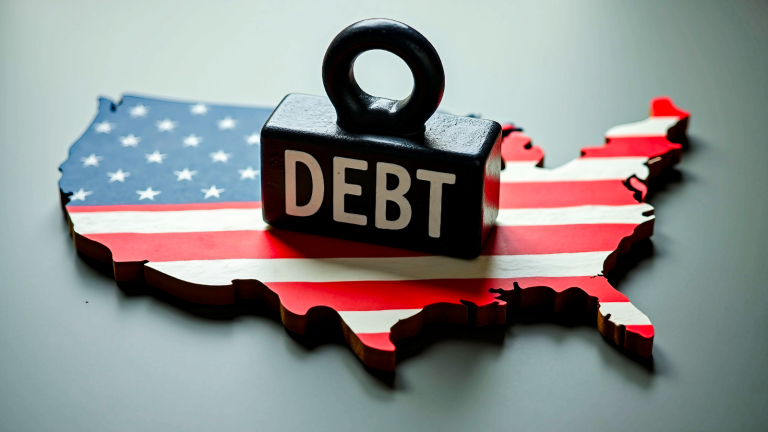Moody’s just downgraded U.S. debt, stripping it of its last AAA credit rating – the gold standard, an untouchable badge of fiscal honor. And if you’ve been tuned in to financial media the past few days, you’d think the sky was falling.
CNBC ran “Breaking News” banners like we were back in 2008. Bloomberg pushed out special alerts. Armchair economists on X were posting at full tilt.
And yet, the stock market barely blinked… because this downgrade is all bark and no bite: a headline-fueled nothing burger.
After all, this isn’t our nation’s first time at this rodeo.
Let’s rewind to an actual landmark moment…
The 2011 Debt Downgrade That Shook Wall Street
August 2011: That was when Standard & Poor’s – one of the Big Three ratings agencies – shocked the financial world by downgrading U.S. debt from AAA to AA+ for the first time in history.
Back then, Washington had just dragged the world through a debt ceiling soap opera that saw weeks of political brinkmanship, threats of default, and last-minute deals. The standoff eroded confidence in the government’s ability to manage its finances, and S&P had had enough.
The reaction? Chaos. Stocks cratered. The S&P 500 dropped almost 7% in a day. The volatility index (VIX) spiked to levels not seen since 2008. It’s fair to say that Wall Street was panicking big-time.
But surely all that mayhem was a harbinger of greater fallout to come?
Not quite. In the long term, the debt downgrade meant nothing.
Stocks rebounded. Treasuries actually rallied.
That’s right: downgrade U.S. debt, and investors rush to buy… more U.S. debt.
Why? Because when things go south, there’s still no place safer to park cash than Uncle Sam’s bank account – even if S&P says it’s not quite as shiny as it used to be.
Fitch’s 2023 Downgrade: Fire Drill or False Alarm?
Now, fast forward to August 2023. Enter Fitch, stage right – the second of the Big Three.
Another downgrade, another round of frightening headlines. But by now, the market had learned a valuable lesson:
Ratings downgrades don’t actually change anything.
Stocks dipped slightly, then dusted off the scare and kept marching higher. Bond yields barely moved. The economic machine kept humming.
Fitch may have pulled the fire alarm, but Wall Street didn’t even look up from its screens.
Moody’s 2025 Move: The Final Chapter in the Downgrade Trilogy
Here we are today. Moody’s, the last holdout, has finally joined the party. It’s like the friend who shows up late to the barbecue with cold hot dogs and asks if folks are ready to eat.
Everyone else already did. The burgers have been eaten. The market has moved on; and so will this news cycle.
This downgrade was inevitable. Moody’s just updated its models, plugged in some fresh deficit projections, tossed in a few political dysfunction coefficients, and out came a new rating. It’s not personal. It’s just math.
But here’s the thing: models don’t run the world. Reality does.
Why U.S. Debt Is Still the Gold Standard of Global Finance
U.S. debt is – and will remain – the safest and most sought-after asset on the planet, for one major reason: it’s backed by the economic output of the most dominant companies in history.
We’re talking:
- Nvidia (NVDA) – the ‘brain’ driving the AI Revolution
- Microsoft (MSFT) – the enterprise empire
- Apple (AAPL) – the global tech religion
- Alphabet (GOOG), Meta (META), Netflix (NFLX), Tesla (TSLA)… need we go on?
These are the companies that power the digital world, run the cloud, shape the culture, and push the boundaries of what’s possible. Their revenues are measured in hundreds of billions. Their margins are obscene, and their growth is exponential.
And they all pay taxes to the U.S. government… Which means, despite Moody’s best efforts, the U.S. Treasury is backed by the strongest business empire the world has ever seen.
That doesn’t sound like AA+ to us.
The Real Investment Story: AI, Not AAA Ratings
Moody’s downgrade might sound spooky, but to us, it’s more Halloween mask than monster. It doesn’t mean that the U.S. is going bankrupt, that Treasury payments are at risk, or that stocks are going to crash.
In fact, it might just mean the opposite…
Because while everyone else panics over an outdated credit score, we see a market gearing up for its next leg higher.
The U.S. economy remains resilient. Consumers are still spending. The Federal Reserve is poised to cut interest rates. And AI is going parabolic.
Moody’s downgrade won’t change the fact that the biggest investment trend of our lifetime – the AI Boom – is just getting started.
So, stay long, strong, and smart.
Get Ready for a Summertime Surge
Don’t let spooky headlines chase you off of Wall Street. Downgrades don’t derail bull markets. They’re just noise – the kind that distracts the crowd while the main act steals the show.
And that main act? It’s AI: productivity, growth, and innovation.
We expect that this summer, the AI-powered rally will explode higher. Stocks are sprinting into a new era of transformation.
Stay focused. Stay bullish. And stay invested in the future.
Because while Moody’s is busy subtracting letters, the market is adding dollars.
Let the others panic. We’ll be too busy profiting.
Our favorite way to play the boom this summer? AI 2.0 stocks: the firms creating the next generation of intelligent humanoid robots.
In the early days of the Internet Revolution, many folks thought that programs like Microsoft Word and Excel would be niche office productivity tools… or that Amazon would be just another bookseller…
Needless to say, they missed out on millionaire-minting gains.
Folks who saw the writing on the wall with companies like Microsoft and Amazon had the chance to amass fortunes.
We believe robotics is a corner of the AI Boom that could be just as profitable.
And if you’re not quite sure which companies to focus on, we have you covered with a special presentation.


